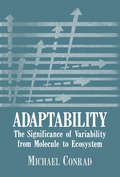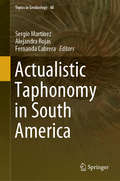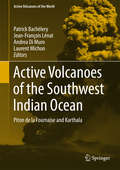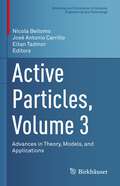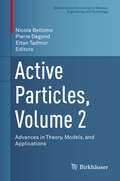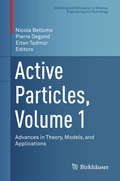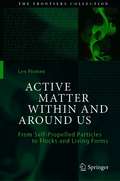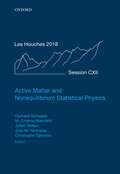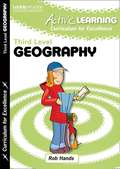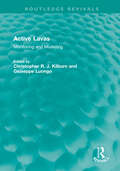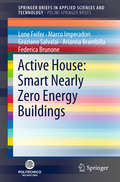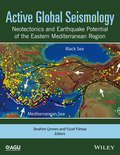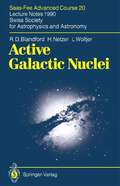- Table View
- List View
Actualistic Taphonomy in South America (Topics in Geobiology #48)
by Sergio Martínez Alejandra Rojas Fernanda CabreraHighlighting the latest research on Actualistic Taphonomy (AT), this book presents the outcomes of a meeting that took place in Montevideo, Uruguay, in October 2017. Its respective chapters offer valuable insights into South American archaeology, invertebrate and vertebrate fauna, and flora. In recent years, there has been a surge of new research on AT, as evidenced by numerous papers, talks, theses, etc. However, there are still very few AT books or even dedicated journal articles. Reflecting the discipline’s newfound maturity, this book, written by South American authors, offers a unique resource for academics and students of Paleontology, Geology, and Biology around the world.
Acts of God: The Unnatural History of Natural Disaster in America
by Ted SteinbergWith the exception of the 9/11 disaster, the top ten most costly catastrophes in U.S. history have all been natural disasters--five of them hurricanes--and all have occurred since 1989. Why this tremendous plague on our homes? In Acts of God, environmental historian Ted Steinberg explains that much of the death and destruction has been well within the realm of human control. Steinberg exposes the fallacy of seeing such calamities as simply random events. Beginning with the 1886 Charleston and 1906 San Francisco earthquakes, and continuing to the present, Steinberg explores the unnatural history of natural calamity, the decisions of business leaders and government officials that have paved the way for the greater losses of life and property, especially among those least able to withstand such blows--America's poor, elderly, and minorities. Seeing nature or God as the primary culprit, Steinberg argues, has helped to hide the fact that some Americans are better protected from the violence of nature than their counterparts lower down the socioeconomic ladder. Sure to provoke discussion, Acts of God is a call to action that must be heard.
Acts of God: The Unnatural History of Natural Disaster in America
by Ted SteinbergAs the waters of the Mississippi River and Lake Pontchartrain began to pour into New Orleans, people began asking the big question--could any of this have been avoided? How much of the damage from Hurricane Katrina was bad luck, and how much was poor city planning? Steinberg's Acts of God is a provocative history of natural disasters in the United States. This revised edition features a new chapter analyzing the failed response to Hurricane Katrina, a disaster Steinberg warned could happen when the book first was published. Focusing on America's worst natural disasters, Steinberg argues that it is wrong to see these tragedies as random outbursts of nature's violence or expressions of divine judgment. He reveals how the decisions of business leaders and government officials have paved the way for the greater losses of life and property, especially among those least able to withstand such blows--America's poor, elderly, and minorities. Seeing nature or God as the primary culprit, Steinberg explains, has helped to hide the fact that some Americans are simply better able to protect themselves from the violence of nature than others. In the face of revelations about how the federal government mishandled the Katrina calamity, this book is a must-read before further wind and water sweep away more lives. Acts of God is a call to action that needs desperately to be heard.
Acts of God: The Unnatural History of Natural Disaster in America
by Ted SteinbergAs the waters of the Mississippi River and Lake Pontchartrain began to pour into New Orleans, people began asking the big question--could any of this have been avoided? How much of the damage from Hurricane Katrina was bad luck, and how much was poor city planning? Steinberg's Acts of God is a provocative history of natural disasters in the United States. This revised edition features a new chapter analyzing the failed response to Hurricane Katrina, a disaster Steinberg warned could happen when the book first was published. Focusing on America's worst natural disasters, Steinberg argues that it is wrong to see these tragedies as random outbursts of nature's violence or expressions of divine judgment. He reveals how the decisions of business leaders and government officials have paved the way for the greater losses of life and property, especially among those least able to withstand such blows--America's poor, elderly, and minorities. Seeing nature or God as the primary culprit, Steinberg explains, has helped to hide the fact that some Americans are simply better able to protect themselves from the violence of nature than others. In the face of revelations about how the federal government mishandled the Katrina calamity, this book is a must-read before further wind and water sweep away more lives. Acts of God is a call to action that needs desperately to be heard.
Active Volcanoes of the Southwest Indian Ocean: Piton de la Fournaise and Karthala (Active Volcanoes of the World)
by Patrick Bachelery Jean-François Lenat Andrea Di Muro Laurent MichonPiton de la Fournaise and Karthala are both shield volcanoes in the southwest Indian Ocean. This publication summarizes the work done on these very active basaltic volcanoes. Piton de la Fournaise has a long history of scientific research and monitoring, with many data collected during recent eruptions. It is certainly one of the most studied volcanoes in the world. The work presented in this monograph includes geological, geophysical, geochemical and petrological aspects, but also studies on physical geography, natural hazards and the sociological and behavioural approaches.'The Karthala volcano may be less well known, but it serves as an interesting comparison to Piton de la Fournaise. Although situated close to the volcanoes of Hawaii, it differs from them by its more alkaline magmas and less frequent activity. It was also monitored for more than 25 years, producing extraordinary eruptions in recent years.
Active Volcanoes of Chiapas: El Chichón And Tacaná (Active Volcanoes of the World)
by Teresa Scolamacchia José Luis MacíasThis publication summarizes the studies carried out at two of the most active volcanoes of Chiapas (Mexico): El Chichón and Tacaná. El Chichón erupted explosively in 1982 killing more than 2000 people being the worst volcanic disaster in Mexico, and Tacaná produced two mild phreatic explosions in 1950 and 1986. Only after these explosions a surge of new studies began to unreveal their volcanic history and impact. This book presents the state of the art advances in topics related to the geologic setting of the two volcanoes, their eruptive history and composition of erupted products, the hydrothermal systems and their manifestations. Volcanic hazards and risks and possible mitigation plans are discussed based on the experience of the catastrophic eruption of El Chichón that occurred in 1982. The book will also include previously unpublished material on the flora and the fauna of the region and archaeological and social aspects of the area that is inhabited by indigenous people.
Active tectonics of the Hellenic subduction zone (Springer Theses)
by Beth ShawThis thesis is remarkable for the wide range of the techniques and observations used and for its insights, which cross several disciplines. It begins by solving a famous puzzle of the ancient world, which is what was responsible for the tsunami that destroyed settlements in the eastern Mediterranean in 365 AD. By radiocarbon dating of preserved marine organisms, Shaw demonstrates that the whole of western Crete was lifted out of the sea by up to 10 meters in a massive earthquake at that time, which occured on a previously unknown fault. The author shows that the resulting tsunami would have the characteristics described by ancient writers, and uses modern GPS measurements and coastline geomorphology to show that the strain build-up near Crete requires such a tsunami-earthquake about every 6.000 years - a major insight into Mediterranean tsunami hazard. A detailed seismological study of earthquakes in the Cretan arc over the last 50 years reveals other important features of its behaviour that were previously unknown. Finally, she provides fundamental insights into the limitations of radiocarbon dating marine organisms, relating to how they secrete carbon into their skeletons. The thesis resulted in three major papers in top journals.
Active Tectonics of Kumaun and Garhwal Himalaya (Springer Natural Hazards)
by R. Jayangondaperumal V. C. Thakur V. Joevivek Priyanka Singh Rao Anil Kumar GuptaThe book contributes to understanding the pattern of strain release and the level of seismic hazard imposed by large-great earthquakes in the frontal fold-thrust belts of Kumaun and Garhwal regions of Uttarakhand. The motivation for active fault studies and their characterization have been emphasized. The book presents the compilation of knowledge garnered in multidisciplinary or proxy studies involved in the understanding of seismic hazard in general and Kumaun–Garhwal Himalaya regions in particular with lucid new maps draped on modern Cartosat or SRTM DEM data. It also discusses satellite image calibration, active faults identifications, and map productions with flowchart. The book discusses window-wise active fault elements with attributes together with the tectonic geomorphic map. It also includes active fault scarp with topographic profile along with field photographs. Finally, it reviews all existing seismotectonic models of the Himalaya, its earthquake hazard, and its vulnerability, specifically for Kumaun and Garhwal regions.
Active Tectonics and Seismic Potential of Alaska (Geophysical Monograph Series #179)
by Jeffrey T. Freymueller Peter J. Haeussler Robert L. Wesson Göran EkströmPublished by the American Geophysical Union as part of the Geophysical Monograph Series, Volume 179. This multidisciplinary monograph provides the first modern integrative summary focused on the most spectacular active tectonic systems in North America. Encompassing seismology, tectonics, geology, and geodesy, it includes papers that summarize the state of knowledge, including background material for those unfamiliar with the region; address global hypotheses using data from Alaska; and test important global hypotheses using data from this region. It is organized around four major themes: subduction and great earthquakes at the Aleutian Arc, the transition from strike slip to accretion and subduction of the Yakutat microplate, the Denali fault and related structures and their role in accommodating permanent deformation of the overriding plate, and regional integration and large-scale models and the use of data from Alaska to address important global questions and hypotheses. The book's publication near the beginning of the National Science Foundation's EarthScope project makes it especially timely because Alaska is perhaps the least understood area within the EarthScope footprint, and interest in the region can be expected to rise with time as more EarthScope data become available.
Active Tectonics and Seismic Potential of Alaska (Geophysical Monograph Series #179)
by Jeffrey T. Freymueller Peter J. Haeussler Robert L. Wesson Göran EkströmPublished by the American Geophysical Union as part of the Geophysical Monograph Series, Volume 179. This multidisciplinary monograph provides the first modern integrative summary focused on the most spectacular active tectonic systems in North America. Encompassing seismology, tectonics, geology, and geodesy, it includes papers that summarize the state of knowledge, including background material for those unfamiliar with the region; address global hypotheses using data from Alaska; and test important global hypotheses using data from this region. It is organized around four major themes: subduction and great earthquakes at the Aleutian Arc, the transition from strike slip to accretion and subduction of the Yakutat microplate, the Denali fault and related structures and their role in accommodating permanent deformation of the overriding plate, and regional integration and large-scale models and the use of data from Alaska to address important global questions and hypotheses. The book's publication near the beginning of the National Science Foundation's EarthScope project makes it especially timely because Alaska is perhaps the least understood area within the EarthScope footprint, and interest in the region can be expected to rise with time as more EarthScope data become available.
Active Seismic Tomography: Theory and Applications
by Kalachand Sain Damodara NaraImaging complex regions or difficult terrains like the sub-volcanic sediments or thrust fold belt areas is crucial to understanding the earth's subsurface. Active Seismic Tomography: Theory and Applications describes current technologies for the study of seismic velocities and the elucidation of fine details of the subsurface. Key use cases include hydrocarbon reservoir characterization, identification of faults and channels, and stratigraphic and structural traps.Volume highlights include: Theory and development of seismic tomographyNumerous examples of the interpretation and analysis of active source seismic data Relevance of tomography data for computational geophysicists This volume is a valuable resource for academics and professionals interested in using or developing integrated imaging approaches of the Earth's subsurface.
Active Seismic Tomography: Theory and Applications
by Kalachand Sain Damodara NaraImaging complex regions or difficult terrains like the sub-volcanic sediments or thrust fold belt areas is crucial to understanding the earth's subsurface. Active Seismic Tomography: Theory and Applications describes current technologies for the study of seismic velocities and the elucidation of fine details of the subsurface. Key use cases include hydrocarbon reservoir characterization, identification of faults and channels, and stratigraphic and structural traps.Volume highlights include: Theory and development of seismic tomographyNumerous examples of the interpretation and analysis of active source seismic data Relevance of tomography data for computational geophysicists This volume is a valuable resource for academics and professionals interested in using or developing integrated imaging approaches of the Earth's subsurface.
Active Particles, Volume 3: Advances in Theory, Models, and Applications (Modeling and Simulation in Science, Engineering and Technology)
by Nicola Bellomo José Antonio Carrillo Eitan TadmorThis edited volume collects six surveys that present state-of-the-art results on modeling, qualitative analysis, and simulation of active matter, focusing on specific applications in the natural sciences. Following the previously published Active Particles volumes, these chapters are written by leading experts in the field and reflect the diversity of subject matter in theory and applications within an interdisciplinary framework. Topics covered include:Variability and heterogeneity in natural swarmsMultiscale aspects of the dynamics of human crowdsMathematical modeling of cell collective motion triggered by self-generated gradientsClustering dynamics on graphsRandom Batch Methods for classical and quantum interacting particle systemsThe consensus-based global optimization algorithm and its recent variantsMathematicians and other members of the scientific community interested in active matter and its many applications will find this volume to be a timely, authoritative, and valuable resource.
Active Particles, Volume 2: Advances in Theory, Models, and Applications (Modeling and Simulation in Science, Engineering and Technology)
by Nicola Bellomo Pierre Degond Eitan TadmorThis volume compiles eight recent surveys that present state-of-the-art results in the field of active matter at different scales, modeled by agent-based, kinetic, and hydrodynamic descriptions. Following the previously published volume, these chapters were written by leading experts in the field and accurately reflect the diversity of subject matter in theory and applications. Several mathematical tools are employed throughout the volume, including analysis of nonlinear PDEs, network theory, mean field approximations, control theory, and flocking analysis. The book also covers a wide range of applications, including:Biological network formationSocial systemsControl theory of sparse systemsDynamics of swarming and flocking systemsStochastic particles and mean field approximationsMathematicians and other members of the scientific community interested in active matter and its many applications will find this volume to be a timely, authoritative, and valuable resource.
Active Particles, Volume 1: Advances in Theory, Models, and Applications (Modeling and Simulation in Science, Engineering and Technology)
by Nicola Bellomo Pierre Degond Eitan TadmorThis volume collects ten surveys on the modeling, simulation, and applications of active particles using methods ranging from mathematical kinetic theory to nonequilibrium statistical mechanics. The contributing authors are leading experts working in this challenging field, and each of their chapters provides a review of the most recent results in their areas and looks ahead to future research directions. The approaches to studying active matter are presented here from many different perspectives, such as individual-based models, evolutionary games, Brownian motion, and continuum theories, as well as various combinations of these. Applications covered include biological network formation and network theory; opinion formation and social systems; control theory of sparse systems; theory and applications of mean field games; population learning; dynamics of flocking systems; vehicular traffic flow; and stochastic particles and mean field approximation. Mathematicians and other members of the scientific community interested in active matter and its many applications will find this volume to be a timely, authoritative, and valuable resource.
Active Matter Within and Around Us: From Self-Propelled Particles to Flocks and Living Forms (The Frontiers Collection)
by Len PismenThis book presents a comprehensive review of various aspects of the novel and rapidly developing field of active matter, which encompasses a wide variety of self-organized self-driven energy-consuming media or agents. Most naturally occurring examples are of biological origin, spanning all scales from intracellular structures to swimming and crawling cells and microorganisms, to living tissues, bacterial colonies and flocks of birds. But the field also encompasses artificial systems, from colloids to soft robots. Intrinsically out of equilibrium and free of constraints of time-reversal symmetry, such systems display a range of surprising and unusual behaviors. In this book, the author emphasizes connections between fluid-mechanical, material, biological and technological aspects of active matter. He employs a minimum of mathematical tools, ensuring that the presentation is accessible to a wider scientific community. Richly illustrated, it gives the reader a clear picture of this fascinating field, its diverse phenomena and its open questions.
Active Matter and Nonequilibrium Statistical Physics: Lecture Notes of the Les Houches Summer School: Volume 112, September 2018 (Lecture Notes of the Les Houches Summer School #112)
From molecular motors to bacteria, from crawling cells to large animals, active entities are found at all scales in the biological world. Active matter encompasses systems whose individual constituents irreversibly dissipate energy to exert self-propelling forces on their environment. Over the past twenty years, scientists have managed to engineer synthetic active particles in the lab, paving the way towards smart active materials. This book gathers a pedagogical set of lecture notes that cover topics in nonequilibrium statistical mechanics and active matter. These lecture notes stem from the first summer school on Active Matter delivered at the Les Houches school of Physics. The lectures covered four main research directions: collective behaviours in active-matter systems, passive and active colloidal systems, biophysics and active matter, and nonequilibrium statistical physics—from passive to active.
Active Learning — Active Geography: Third Level (PDF)
by Rob Hands Leckie Leckie StaffFocusing specifically on building skills – both geographical and higher order thinking skills – Active Geography covers the Third Level Outcomes and Experiences for geography in an engaging, activity-based way. Containing project ideas, co-operative learning tasks, literacy-based activities and games, it offers a toolkit of ideas to help you effectively implement Curriculum for Excellence with your class.
Active Lavas: Monitoring and Modelling (Routledge Revivals)
by Christopher R.J. Kilburn Giuseppe LuongoOriginally published in 1993, Active Lavas looks at the practical aspects of monitoring uncontrolled streams of molten rock and how field data can be applied for theoretical modelling and forecasting the growth of lava flows. It describes the basic features of common subaerial lava flows and domes – both on Earth and on other bodies in the Solar System – before discussing the logistics of measuring lava properties during eruption and how these measurements are used to develop simple theoretical models for forecasting flow behaviour.
Active Lavas: Monitoring and Modelling (Routledge Revivals)
by Christopher R. J. Kilburn Giuseppe LuongoOriginally published in 1993, Active Lavas looks at the practical aspects of monitoring uncontrolled streams of molten rock and how field data can be applied for theoretical modelling and forecasting the growth of lava flows. It describes the basic features of common subaerial lava flows and domes – both on Earth and on other bodies in the Solar System – before discussing the logistics of measuring lava properties during eruption and how these measurements are used to develop simple theoretical models for forecasting flow behaviour.
Active House: Smart Nearly Zero Energy Buildings (SpringerBriefs in Applied Sciences and Technology)
by Lone Feifer Marco Imperadori Graziano Salvalai Arianna Brambilla Federica BrunoneThe book provides an overview of the Active House (AH) vision, intended as a building design method “beyond” the passive approach for buildings of the future that will be more and more connected, smart and innovative. It offers a novel philosophical design approach in which buildings, new or renovated, are in balance with natural, renewable energies and become “concentrators-distributors” of energies instead of being consumers of resources. The book is composed of five chapters, providing information on fundamental aspects of innovations toward resource-efficient buildings, as well as case studies presenting the concept in practice. It demonstrates that a completely new design approach is possible, and that a turning point has been reached. Lastly, it shows how the AH Alliance, along with designers, institutions, industries and academies, is bringing a breath of fresh air to the world of construction.
Active Global Seismology: Neotectonics and Earthquake Potential of the Eastern Mediterranean Region (Geophysical Monograph Series #225)
by Ibrahim Cemen Yucel YilmazNeotectonics involves the study of the motions and deformations of the Earth's crust that are current or recent in geologic time. The Mediterranean region is one of the most important regions for neotectonics and related natural hazards. This volume focuses on the neotectonics of the Eastern Mediterranean region, which has experienced many major extensive earthquakes, including the devastating Izmit, Turkey earthquake on August 17, 1999. The event lasted for 37 seconds, killing around 17,000 people, injuring 44,000 people, and leaving approximately half a million people homeless. Since then, several North American, European, and Turkish research groups have studied the neotectonics and earthquake potential of the region using different geological and geophysical methods, including GPS studies, geodesy, and passive source seismology. Some results from their studies were presented in major North American and European geological meetings. This volume highlights the work involving the Eastern Mediterranean region, which has one of the world's longest and best studied active strike-slip (horizontal motion) faults: the east-west trending North Anatolian fault zone, which is very similar to the San Andreas fault in California. This volume features discussions of: Widespread applications in measuring plate motion that have strong implications in predicting natural disasters like earthquakes, both on a regional and a global scale Recent motions, particularly those produced by earthquakes, that provide insights on the physics of earthquake recurrence, the growth of mountains, orogenic movements, and seismic hazards Unique methodical approaches in collecting tectonophysical data, including field, seismic, experimental, computer-based, and theoretical approaches. Active Global Seismology is a valuable resource for geoscientists, particularly in the field of tectonophysics, geophysics, geodynamics, seismology, structural geology, environmental geology, and geoengineering. Read an interview with the editors to find out more:https://eos.org/editors-vox/neotectonics-and-earthquake-forecasting
Active Global Seismology: Neotectonics and Earthquake Potential of the Eastern Mediterranean Region (Geophysical Monograph Series #225)
by Ibrahim Emen Yucel YilmazNeotectonics involves the study of the motions and deformations of the Earth's crust that are current or recent in geologic time. The Mediterranean region is one of the most important regions for neotectonics and related natural hazards. This volume focuses on the neotectonics of the Eastern Mediterranean region, which has experienced many major extensive earthquakes, including the devastating Izmit, Turkey earthquake on August 17, 1999. The event lasted for 37 seconds, killing around 17,000 people, injuring 44,000 people, and leaving approximately half a million people homeless. Since then, several North American, European, and Turkish research groups have studied the neotectonics and earthquake potential of the region using different geological and geophysical methods, including GPS studies, geodesy, and passive source seismology. Some results from their studies were presented in major North American and European geological meetings. This volume highlights the work involving the Eastern Mediterranean region, which has one of the world's longest and best studied active strike-slip (horizontal motion) faults: the east-west trending North Anatolian fault zone, which is very similar to the San Andreas fault in California. This volume features discussions of: Widespread applications in measuring plate motion that have strong implications in predicting natural disasters like earthquakes, both on a regional and a global scale Recent motions, particularly those produced by earthquakes, that provide insights on the physics of earthquake recurrence, the growth of mountains, orogenic movements, and seismic hazards Unique methodical approaches in collecting tectonophysical data, including field, seismic, experimental, computer-based, and theoretical approaches. Active Global Seismology is a valuable resource for geoscientists, particularly in the field of tectonophysics, geophysics, geodynamics, seismology, structural geology, environmental geology, and geoengineering. Read an interview with the editors to find out more:https://eos.org/editors-vox/neotectonics-and-earthquake-forecasting
Active Galactic Nuclei: Saas-Fee Advanced Course 20. Lecture Notes 1990. Swiss Society for Astrophysics and Astronomy (Saas-Fee Advanced Course #20)
by R.D. Blandford H. Netzer L. WoltjerThe Swiss Society for Astrophysics and Astronomy organizes each year in the late winter or early spring an advanced course. The format of the school is always iden tical: three leading lecturers are invited to cover the subject in nine or ten lectures each and to deliver a written version of their lecture notes. Lectures are held in the morning and late afternoon, thus leaving ample time for discussion and skiing. These arrangements prove very convivial and lead to an excellent atmosphere in which to learn exciting new subjects and establish contacts with colleagues. A wide variety of people attend the school, including many young students, mostly from Europe, and some experienced researchers. The 20th Advanced Course of the Swiss Society for Astrophysics and Astronomy took place in Les Diablerets from 1 to 6 April 1990. It was devoted to observational and theoretical aspects of active galactic nuclei. The previous advanced courses of the Swiss Society for Astrophysics and Astronomy have regularly taken place in Saas-Fee, a small resort in the Swiss Alps, hence the name "Saas-Fee" used to de scribe the courses and lecture notes. In the last three years, however, the course was organized in Leysin and in Les Diablerets, both also situated in the Swiss Alps.
